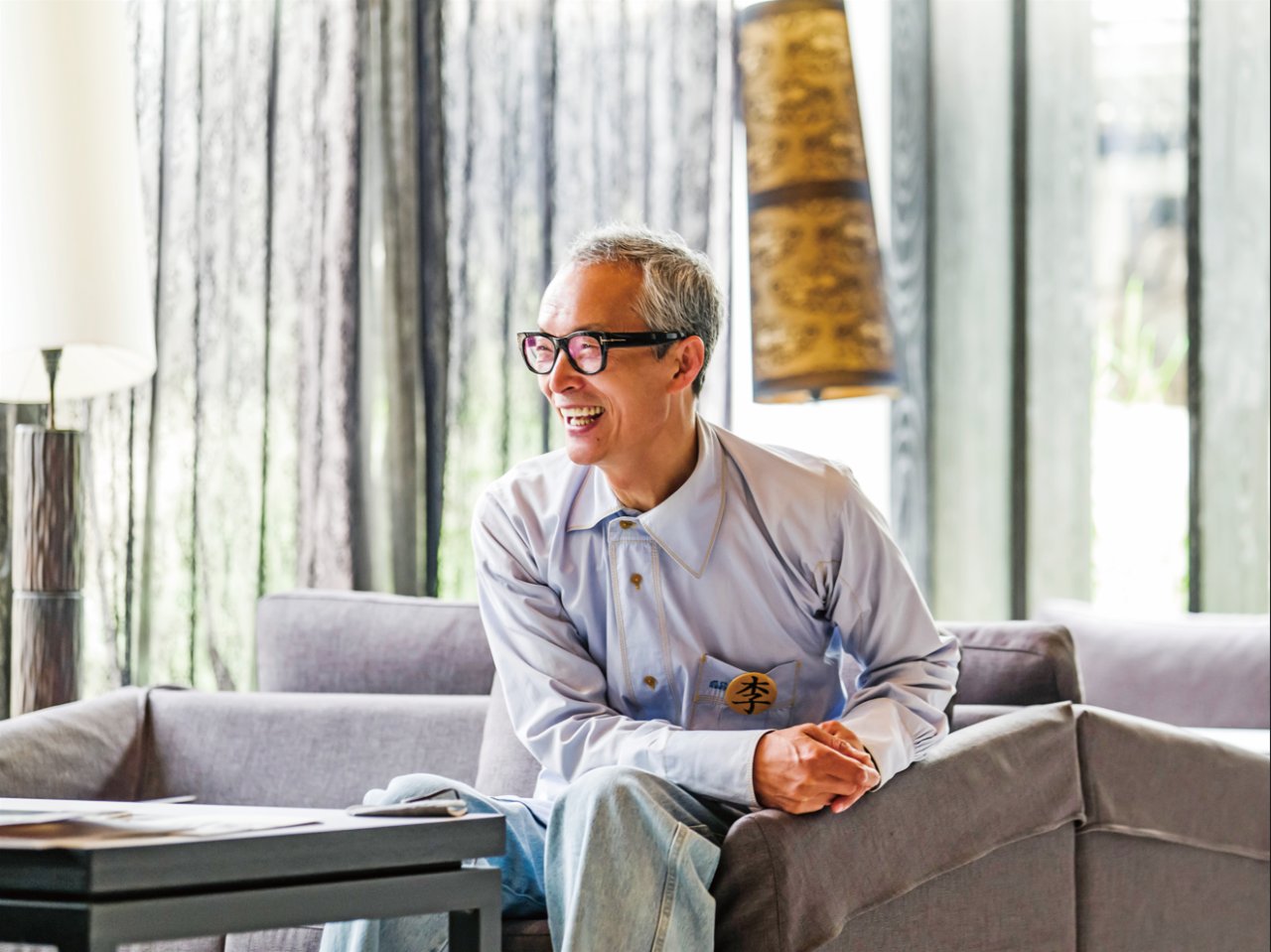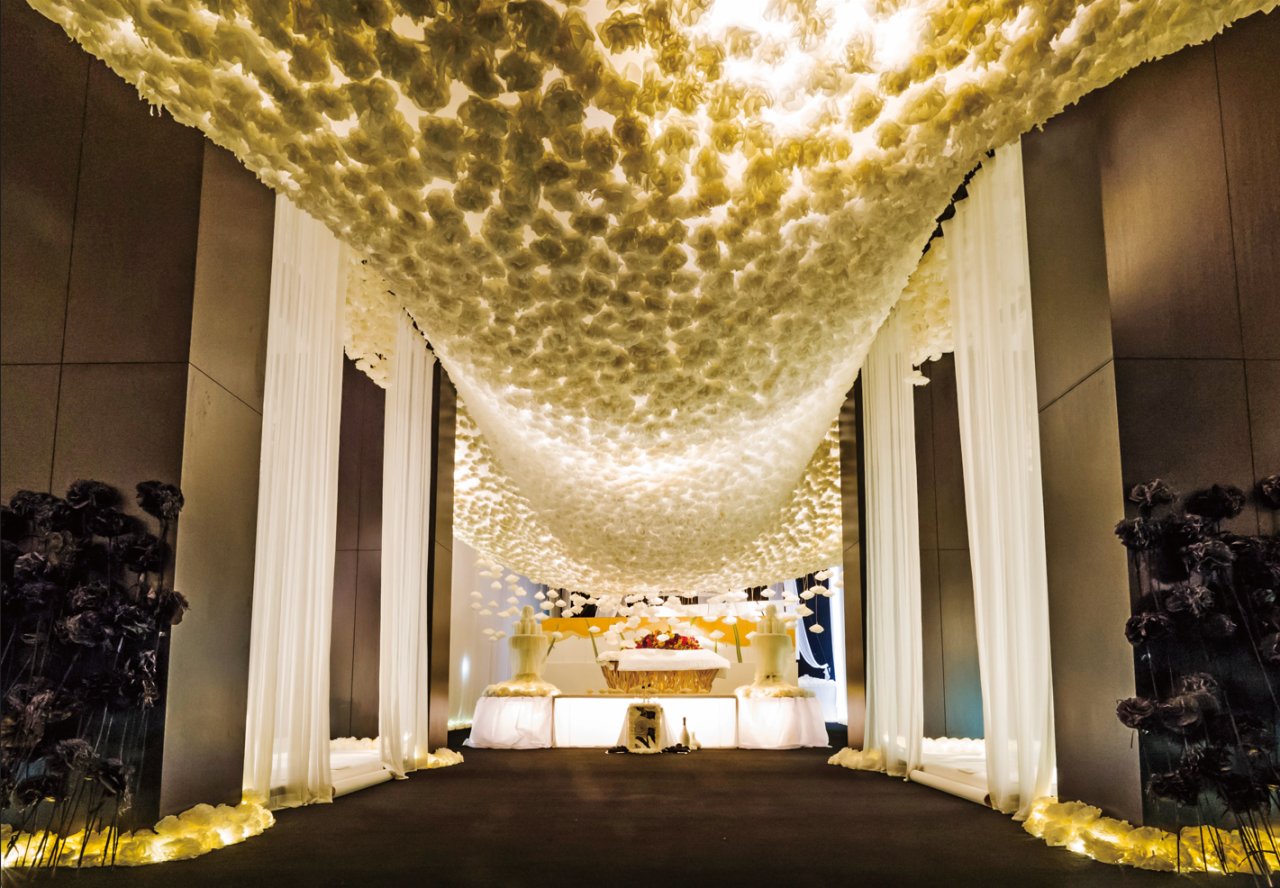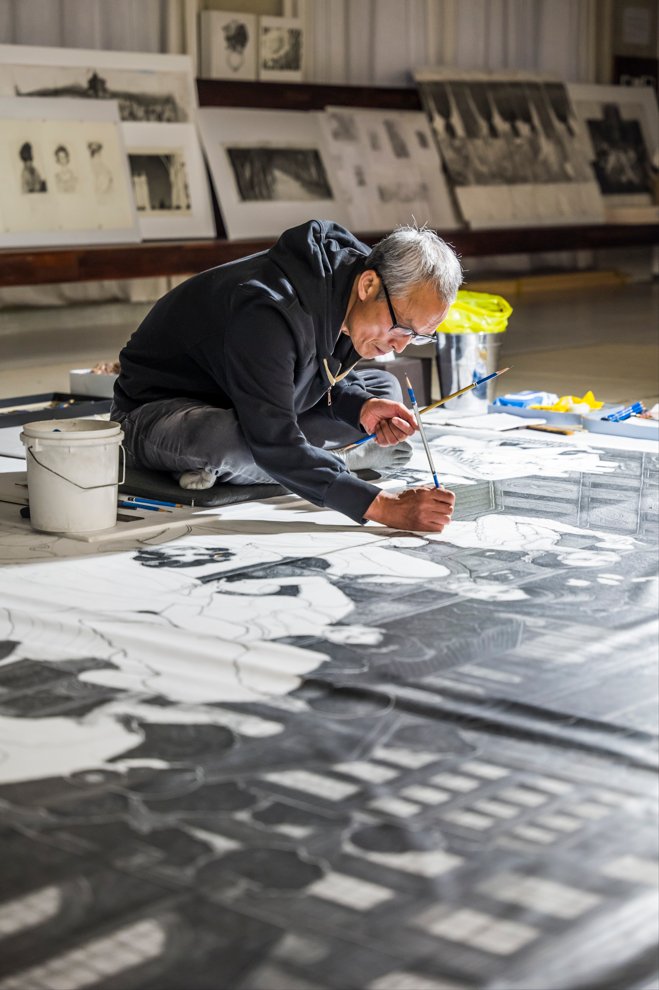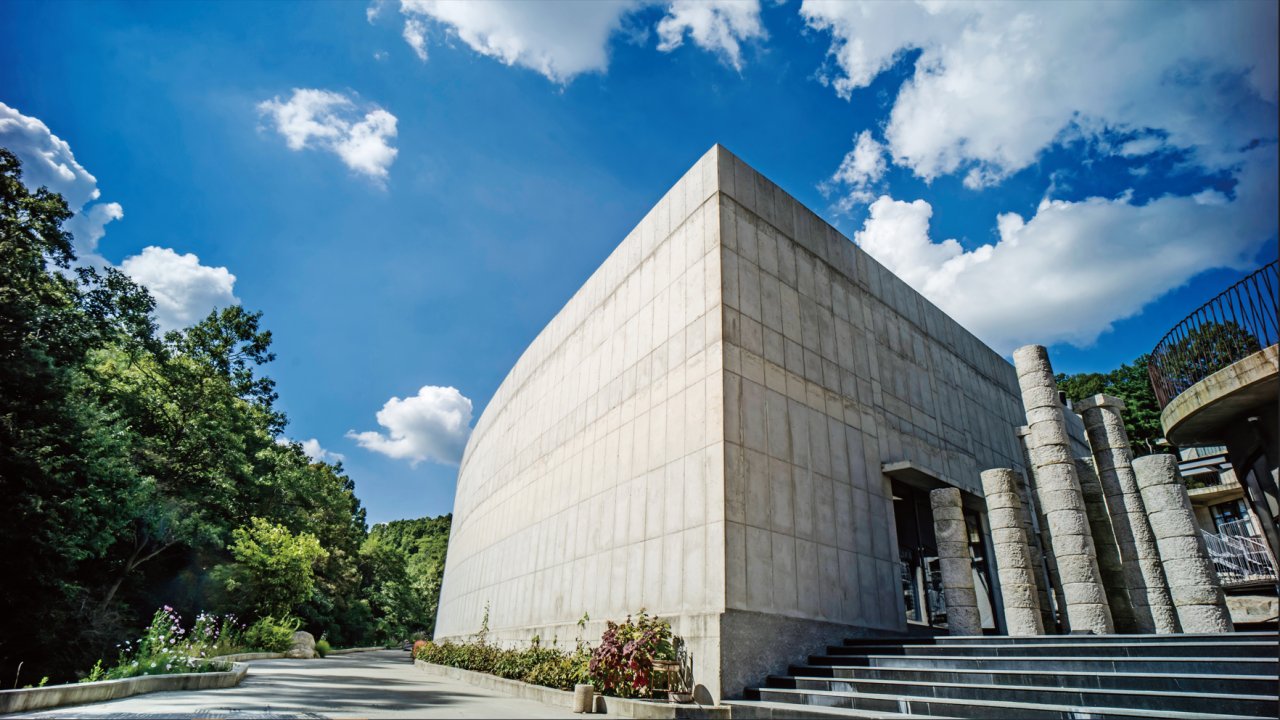[Eye interview] Hair stylist-turned-artist realizes his vision on a mountain side resort
Lee Sang-il presents ideal of man in harmony with nature at L’art de la vie
By Kim Hoo-ranPublished : June 24, 2022 - 09:30

ICHEON, Gyeonggi Province -- When Lee Sang-il, 66, a hairdresser to celebrities, the artsy and ladies-who-lunch, retired some 10 years ago, he hinted that he was about to embark on a very big project. “Keep me posted,” I said.
Over the years, he did indeed keep me posted with occasional text messages. And about five years ago, I received photos of a snow-covered hanok and an update: His resort was 90 percent complete.
Then came an invitation to the opening party in early May. An hour and a half on a highway and winding countryside roads, an incredible scene unfolded. A massive concrete building stood at the foot of a gently sloping mountain across a babbling stream. Standing guard near the entrance to the resort -- L’art de la vie, meaning “the art of life” -- were the stone pillars that had once stood tall inside Lee’s cafe in Sinsa-dong, one floor below his hair salon.
The imposing building at the entrance to L’art de la vie is an art exhibition hall dedicated to Lee’s works -- large-scale installations and giant panels of pencil drawings. It is part of the resort that has eight private lodgings, three hanok lodgings, as well as an Italian restaurant, a cafe and a soon-to-open Korean restaurant.
Wine flowed freely at the garden party, where Lee’s old friends and clients gathered to congratulate him on the opening of a new chapter in his life.
Over the years, he did indeed keep me posted with occasional text messages. And about five years ago, I received photos of a snow-covered hanok and an update: His resort was 90 percent complete.
Then came an invitation to the opening party in early May. An hour and a half on a highway and winding countryside roads, an incredible scene unfolded. A massive concrete building stood at the foot of a gently sloping mountain across a babbling stream. Standing guard near the entrance to the resort -- L’art de la vie, meaning “the art of life” -- were the stone pillars that had once stood tall inside Lee’s cafe in Sinsa-dong, one floor below his hair salon.
The imposing building at the entrance to L’art de la vie is an art exhibition hall dedicated to Lee’s works -- large-scale installations and giant panels of pencil drawings. It is part of the resort that has eight private lodgings, three hanok lodgings, as well as an Italian restaurant, a cafe and a soon-to-open Korean restaurant.
Wine flowed freely at the garden party, where Lee’s old friends and clients gathered to congratulate him on the opening of a new chapter in his life.

“More than 400 came to my parties,” says Lee when I return to L’art de la vie in Moga-myeon, Icheon, Gyeonggi Province, on June 7 for an interview. He said he was grateful and touched that so many people had accepted his invitation. After all, it had been quite some time since he retired at the end of 2012, ending his celebrated career as a hair designer after more than 30 years.
The decision to retire, somewhat early, was made after showing “Last Beauty,” his large-scale installation work depicting his death and funeral, at Seoul Living Design Fair in 2012. By that time, he had been drawing for some years, living in an old hanok in Oeam village in South Chungcheong Province for part of the week, where he drew day and night.
Drawing was a newly discovered passion, occasioned by his wife’s departure for Europe to study jewelry design. At home alone after a long day at work, he one day picked up an eyebrow pencil from his wife’s dressing table and began drawing on the back of a used piece of paper he found in the living room.
Work on the resort began in 2014. The land had been purchased several years before that. “I was instantly attracted by the peach blossoms, the gentle mountain slope and the valley. When I turned over a rock in the stream, I found a freshwater crawfish. It brought back memories of my younger days,” he says.
The original plan was to build a small house where the couple would grow old, Lee spending his days drawing. His wife, Kim In-sook, however, had a different idea. It would be a selfish luxury to have this beautiful place all to themselves, she told him. “Let’s open a cultural space,” he recalls his wife urging him.
The decision to retire, somewhat early, was made after showing “Last Beauty,” his large-scale installation work depicting his death and funeral, at Seoul Living Design Fair in 2012. By that time, he had been drawing for some years, living in an old hanok in Oeam village in South Chungcheong Province for part of the week, where he drew day and night.
Drawing was a newly discovered passion, occasioned by his wife’s departure for Europe to study jewelry design. At home alone after a long day at work, he one day picked up an eyebrow pencil from his wife’s dressing table and began drawing on the back of a used piece of paper he found in the living room.
Work on the resort began in 2014. The land had been purchased several years before that. “I was instantly attracted by the peach blossoms, the gentle mountain slope and the valley. When I turned over a rock in the stream, I found a freshwater crawfish. It brought back memories of my younger days,” he says.
The original plan was to build a small house where the couple would grow old, Lee spending his days drawing. His wife, Kim In-sook, however, had a different idea. It would be a selfish luxury to have this beautiful place all to themselves, she told him. “Let’s open a cultural space,” he recalls his wife urging him.

For two years, Lee went about preparing the land, removing rocks and clearing fallen tree trunks, all by hand. He shows me his hands -- they are not the hands of an artist, but a day laborer -- calloused and hardened.
His art is everywhere around the resort. How did he amass such a large collection, I ask. He gets up well before dawn, he says. “I draw from 3 a.m. to 7 a.m.,” he says. His works are mostly large-scale pencil drawings requiring hours and hours of painstaking work. At 7:30 a.m., he begins working on the resort grounds.
“To keep the grounds looking natural actually requires a lot of labor,” he says, explaining how the flowers in the meadow were planted to look as natural as possible. The red poppies were strategically planted among other flowers, for example. “A garden is another way of expressing one’s self,” says Lee, whose salon always had a lavish arrangement of fresh flowers.
Preserving nature and incorporating the buildings naturally into the environment was the major focus of Lee’s work. Lee designed all the buildings, including the brick lodgings and hanok. He drew the buildings first, built them working with local builders and carpenters and then had the blueprints drawn up after everything was completed so that the buildings could be certified by the authorities. He not only provided the vision for the project but executed the project as well. This does not come as a surprise knowing him to be a stickler for details. He had also had accrued much experience designing buildings, including his hair salons.
“The rocks, the stones, the trees, the earth, the water. They are the ‘owners’ of this land,” Lee says, explaining his philosophy in building. L’art de la vie reflects that philosophy well. The large rock at the back of the art exhibition hall was preserved as a focal point of the resort and the restaurants, cafe and other larger buildings were built without disturbing the natural ridge of the mountain. Pilotis were employed for the brick lodgings so that the hillsides would be least tampered with.
His art is everywhere around the resort. How did he amass such a large collection, I ask. He gets up well before dawn, he says. “I draw from 3 a.m. to 7 a.m.,” he says. His works are mostly large-scale pencil drawings requiring hours and hours of painstaking work. At 7:30 a.m., he begins working on the resort grounds.
“To keep the grounds looking natural actually requires a lot of labor,” he says, explaining how the flowers in the meadow were planted to look as natural as possible. The red poppies were strategically planted among other flowers, for example. “A garden is another way of expressing one’s self,” says Lee, whose salon always had a lavish arrangement of fresh flowers.
Preserving nature and incorporating the buildings naturally into the environment was the major focus of Lee’s work. Lee designed all the buildings, including the brick lodgings and hanok. He drew the buildings first, built them working with local builders and carpenters and then had the blueprints drawn up after everything was completed so that the buildings could be certified by the authorities. He not only provided the vision for the project but executed the project as well. This does not come as a surprise knowing him to be a stickler for details. He had also had accrued much experience designing buildings, including his hair salons.
“The rocks, the stones, the trees, the earth, the water. They are the ‘owners’ of this land,” Lee says, explaining his philosophy in building. L’art de la vie reflects that philosophy well. The large rock at the back of the art exhibition hall was preserved as a focal point of the resort and the restaurants, cafe and other larger buildings were built without disturbing the natural ridge of the mountain. Pilotis were employed for the brick lodgings so that the hillsides would be least tampered with.

The couple’s extensive overseas travels, often to remote and exotic places, even while he was working in the cut-throat beauty industry, has served him well. Their influences are scattered throughout the resort, down to the colorful elongated sculptures of men in hats he brought back from a trip to Africa that stand near a window at the cafe. Most of the sculptures face the window, appearing to look outside, but a few have been turned to look inside the cafe. Yet another attention to detail that is whimsical.
Of course, there were difficulties along the way. “I nearly gave up three or four times because I was having difficulties realizing my vision,” he says, crediting his wife for pushing him on, encouraging him.
Lee seems the happiest I have ever seen him, a smile of contentment lingering on his lips, his eyes twinkling with boyish excitement. After all, he has given shape and form to his ideals and has achieved the freedom to pursue his interest.
Does he worry about the business side of things?
The only reason he was able to undertake the seemingly improbable project was because there was an understanding that his children would not inherit his wealth, he explains. “All I wish for now is to make just enough money to pay the staff,” he says.
In the meantime, he has other projects already brewing in his head. Turning a mountain, which lay abandoned after being mined, into an art space is one of them.
“I think my talent may be creating spaces where one can develop new thoughts, ideas,” he says. “I have learned a lot by being in nature. I am changing every day as a result and I hope everyone can change a little, too, by being in nature.”
Of course, there were difficulties along the way. “I nearly gave up three or four times because I was having difficulties realizing my vision,” he says, crediting his wife for pushing him on, encouraging him.
Lee seems the happiest I have ever seen him, a smile of contentment lingering on his lips, his eyes twinkling with boyish excitement. After all, he has given shape and form to his ideals and has achieved the freedom to pursue his interest.
Does he worry about the business side of things?
The only reason he was able to undertake the seemingly improbable project was because there was an understanding that his children would not inherit his wealth, he explains. “All I wish for now is to make just enough money to pay the staff,” he says.
In the meantime, he has other projects already brewing in his head. Turning a mountain, which lay abandoned after being mined, into an art space is one of them.
“I think my talent may be creating spaces where one can develop new thoughts, ideas,” he says. “I have learned a lot by being in nature. I am changing every day as a result and I hope everyone can change a little, too, by being in nature.”












![[Today’s K-pop] BTS pop-up event to come to Seoul](http://res.heraldm.com/phpwas/restmb_idxmake.php?idx=644&simg=/content/image/2024/04/17/20240417050734_0.jpg&u=)





![[KH Explains] Hyundai's full hybrid edge to pay off amid slow transition to pure EVs](http://res.heraldm.com/phpwas/restmb_idxmake.php?idx=652&simg=/content/image/2024/04/18/20240418050645_0.jpg&u=20240419100350)

![[Today’s K-pop] Zico drops snippet of collaboration with Jennie](http://res.heraldm.com/phpwas/restmb_idxmake.php?idx=642&simg=/content/image/2024/04/18/20240418050702_0.jpg&u=)